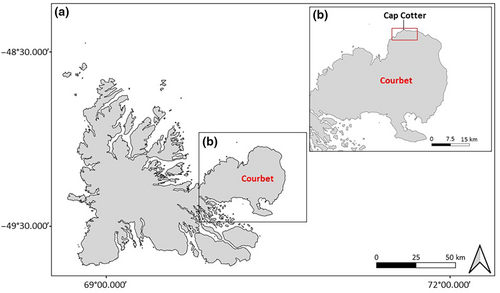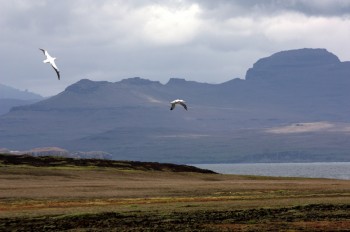
Overall map of Kerguelen (a) and Courbet Peninsula (b). The red rectangle in panel (b) refers to our study area. From the publication
Charlotte Bourgoin (Centre de Recherche sur la Biodiversité et l'Environnement, Université de Toulouse, France) and colleagues have published in the journal Ecology and Evolution on what effects brooding by Vulnerable Wandering Albatrosses Diomedea exulans on Kerguelen.
The paper’s abstract follows:
“Parental investment increases offspring fitness at the expense of the parent's ability to invest in other offspring. In many animal species, parents guard their offspring after birth. The parental decision over the duration of this period is expected to be triggered by the associated fitness costs and benefits for both offspring and parents. Here, we evaluated the relevance of several intrinsic and environmental variables in determining brooding period duration in the wandering albatross (Diomedea exulans) and questioned whether brooding duration was related to chick subsequent survival and biometry prior to fledging. We used a semi-experimental design to increase the variance in cat abundance, a recent predator of albatross chicks, and predicted that an increased predation risk at the nest scale would trigger longer chick brooding and thus, protection. In addition, we questioned the influence of weather conditions, hatching date, and characteristics of chicks (sex and biometry) and parents (sex and age) on brooding duration. We report no effect of predation risk or parental characteristics on brooding duration. However, the probability for a parent to end brooding decreased with forthcoming unfavorable weather. Our data also revealed reduced brooding duration for late-hatched chicks and a positive association between brooding duration and chick structural size, and between the frequency of shifts between parents and chick structural size. Finally, brooding duration was not associated with chick survival or with chick biometry prior to fledging. We discuss these results in light of pre-existing hypotheses on fitness costs and benefits associated with brooding duration for chicks and parents.”

Wandering Albatrosses over the Courbet Peninsula, Kerguelen, photograph by Maite Louzao
Reference:
Bourgoin, C., Barbraud, C., Getti, T, Delord, K., Bodin, A. & Blanchard, P. 2024. Brooding duration does not depend on cat predation risk but is related to weather and phenology in the wandering albatross (Diomedea exulans). Ecology and Evolution 14 (9).
John Cooper, Emeritus Information Officer, Agreement on the Conservation of Albatrosses and Petrels, 31 March 2025

 English
English  Français
Français  Español
Español